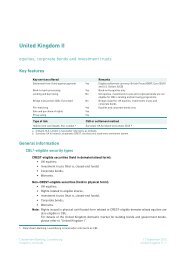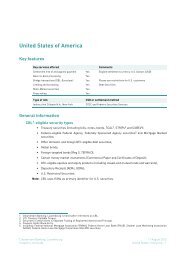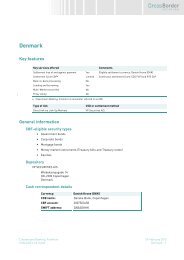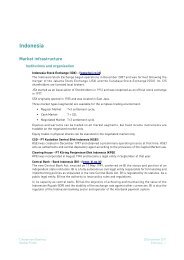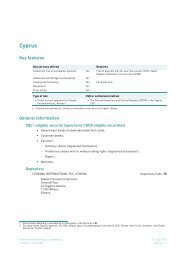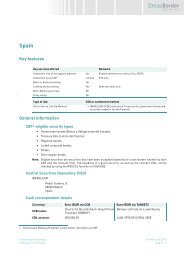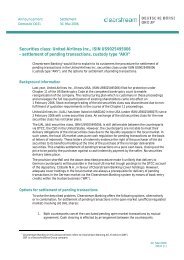An introduction to the European Post-Trade Market - Clearstream
An introduction to the European Post-Trade Market - Clearstream
An introduction to the European Post-Trade Market - Clearstream
Create successful ePaper yourself
Turn your PDF publications into a flip-book with our unique Google optimized e-Paper software.
Exhibit 10: Costs of wholesale and retail cross-border transactions<br />
Estimated average cost per transaction, 2001, in basis points 1)<br />
Wholesale 2) Retail 3)<br />
22.5<br />
+29%<br />
29.1<br />
1) 1 basis point is 1/100 of a percentage point<br />
2) Example: wholesale trade of €200,000<br />
3) Example: retail trade of €5,000<br />
45.0<br />
Domestic Cross-border Domestic Cross-border<br />
Source: Deutsche Börse AG/<strong>Clearstream</strong> International S.A., 2002<br />
of cross-border transactions is low and orders have <strong>to</strong> be processed manually. This increases costs and<br />
operational risk. In contrast <strong>to</strong> <strong>the</strong> two o<strong>the</strong>r cost drivers, <strong>the</strong> complexity of legal and tax procedures<br />
cannot be directly controlled by post-trade services providers. Hence, in order <strong>to</strong> reduce cross-border<br />
post-trade prices, it is imperative <strong>to</strong> harmonise legal and tax regimes.<br />
4.3 Effectiveness of existing governance structures<br />
Over <strong>the</strong> last decade, <strong>the</strong> <strong>European</strong> post-trade industry has undergone major governance changes,<br />
in particular regarding CSDs. Most CSDs have been demutualised and some players have adopted<br />
a for-profit orientation. Despite differences in governance structures, all major <strong>European</strong> CSDs have<br />
been able <strong>to</strong> reduce <strong>the</strong>ir unit costs and respective prices. They have successfully improved <strong>the</strong>ir<br />
technology and settlement liquidity.<br />
Prices have fallen over <strong>the</strong> last years<br />
THE EUROPEAN POST-TRADE MARKET<br />
Competition, Efficiency, and Governance<br />
Between 1996 and 2003 settlement prices (approximated by settlement-related revenues of CSDs<br />
divided by <strong>the</strong> number of pre-netting transactions) came down in all major <strong>European</strong> markets. 49) The<br />
(unweighted) average price fell by 69 percent from €1.58 <strong>to</strong> €0.49 (exhibit 11). The price decline<br />
was strongest for <strong>Clearstream</strong> Banking Frankfurt, a company with a for-profit orientation.<br />
The above-mentioned analysis suggests that governance structures do not explain differences in <strong>the</strong><br />
dynamic performance of CSDs. Ra<strong>the</strong>r, <strong>the</strong> efficiency gains are due <strong>to</strong> innovations and <strong>to</strong> increased<br />
settlement liquidity. 50)<br />
48) This section focuses on CSDs, for <strong>the</strong> current debate concerns <strong>the</strong> effect of utility or for-profit governance structures on <strong>the</strong> efficiency of CSDs.<br />
49) See footnote 42 for details on <strong>the</strong> methodology.<br />
+152%<br />
113.5<br />
50) In Europe (EU15), <strong>the</strong> number of settlement transactions has increased by 252 percent between 1996 and 2003. The average settlement price<br />
has gone down due <strong>to</strong> large volume-dependent rebates. On average, a 100-percent increase in transaction volume has led <strong>to</strong> a 28-percent<br />
decline in <strong>the</strong> price per settlement transaction.<br />
48)<br />
27






